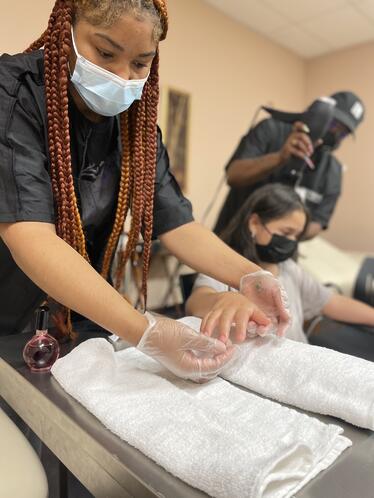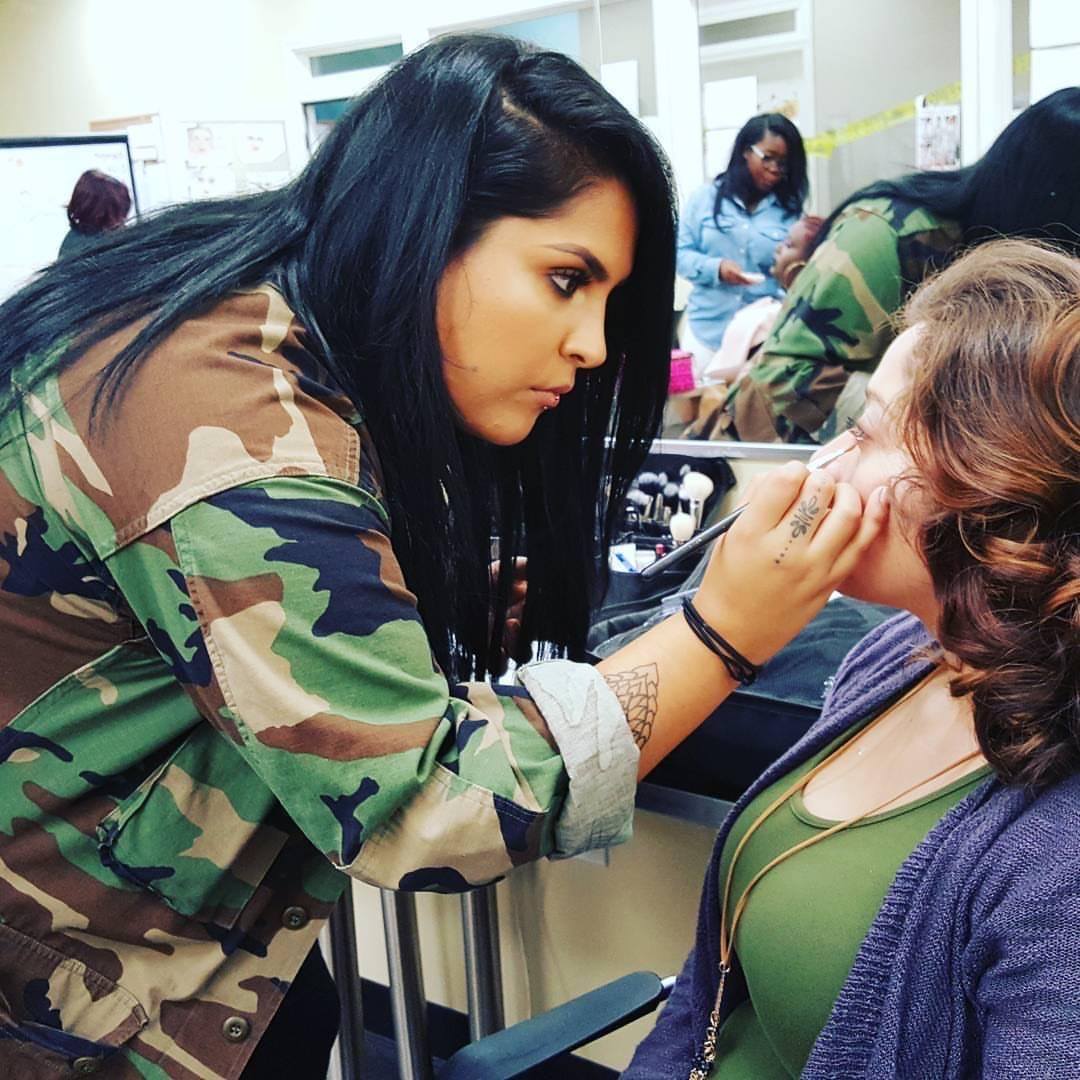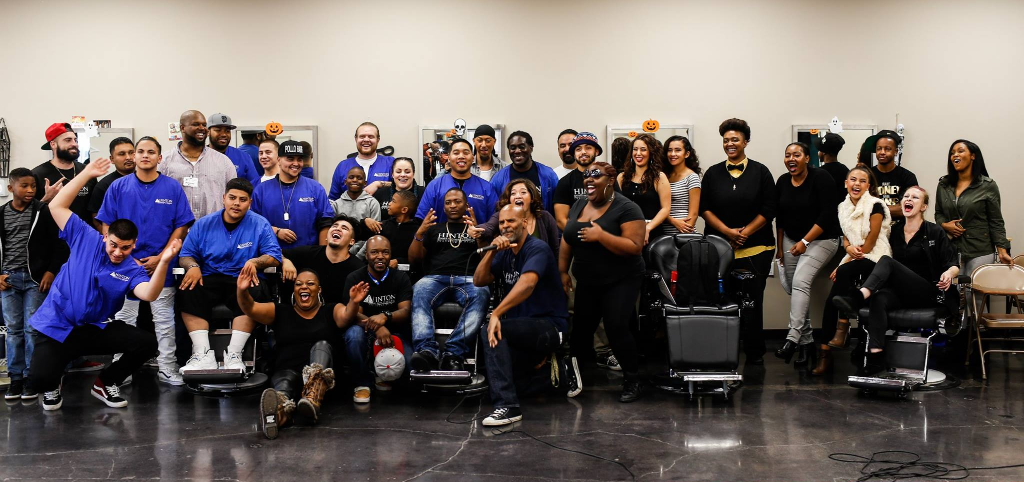
What Does The Future Look Like For A Cosmetologist?
If you’ve ever stepped into a hair salon or gotten your makeup professionally done, you most likely worked with a trained cosmetologist. Cosmetologists are professionals who help people with their hair, skin, and nails. This includes hairstylists, makeup artists, manicurists, and those who provide facials and hair removal, among other services. Jobs in the cosmetology field are expected to grow 19 percent from 2020 to 2030, making it a fast-growing industry within the United States. The ability to make a living as a cosmetologist as a self-employed business owner is great, as many hairstylists and makeup artists are able to work for themselves as their own bosses. In fact, over 43 percent of cosmetologists are self-employed, with many owning their own salons or traveling to customers to provide services.

Cosmetologists often are friendly, are good listeners, provide good customer service skills, and have the ability to establish rapport with clients. Additionally, cosmetologists often must have physical stamina as they’re often standing throughout the day as they work on people’s hair and skin care needs. To become a cosmetologist in most states, people must receive training at a California state-approved institution that provides licensure at the end of the program. How long does it take to complete cosmetology school? usually take 1,000 to 1,500 hours of instruction time to achieve or 12 to 14 months. California also allows for people to complete apprenticeships with professionals in the field in place of a training program. With a certificate in hand, a person can make a good living, especially if they offer quality services and have an entrepreneurial spirit.

Training to Become a Cosmetologist in California
So you’ve decided you want to become a cosmetologist and need to find a training program that will fit your needs. While you search for the perfect training schools, think about what kinds of training programs you can dedicate yourself to. Will you be able to attend the program full-time or part-time only? Is the program something you can afford or find financial aid to be able to pay for it? Is the school close by and/or does it offer virtual lessons in addition to hands-on learning? All of these things need to be taken into account when deciding on the perfect training program for you.
In addition, you’ll want to make sure that the cosmetology school of your choice is approved by the State of California to provide training in cosmetology and is able to provide licensure upon your graduation from the program. Perform a search on the cosmetology school to see its ratings and reviews from other previous students. Check to see on their website that they are an approved training program with the state of California, especially for the specialty of work you want to get into, such as hairstyling, or Check with the Bureau for Private Postsecondary Education here to make sure that the school you’re thinking about will offer the training and certification you’ll need to start a cosmetology career.

Difference Between Accredited vs. Non-Accredited Cosmetology Schools
While trying to decide which school you want to attend, keep in mind that there are different types of schools depending on which entity has approved of them. A state-approved school could simultaneously be accredited by a different entity or none at all.
Accredited Cosmetology Schools
An accredited cosmetology school is simply put a school that has passed a standard put forth by a group of professionals in that field. These accreditations can make the school more attractive to not only the student, but the potential client once that student has graduated. Some cosmetology accreditation agencies include the National Accrediting Commission of Career Arts and Sciences (NACCAS) and the Council on Occupational Education (COE). The Department of Education must approve these accrediting agencies. Once a school has been accredited, it can then apply to the Department of Education to offer financial aid for students who qualify.
The process to become accredited with an agency such as the NACCAS can be time-consuming and strict. For instance, a school with NACCAS accreditation must go through a reporting process after having been in existence for at least two years. NACCAS must document that the school is maintaining compliance with a standard of excellence. These standards of excellence are informed by national expectations formed by Congress and the Department of Education. A school must adhere to these guidelines in order to maintain accreditation and can lose its standing with the accrediting agency at any time if they fail to do so.
State-Approved Cosmetology Schools
The State of California requires cosmetology training programs to provide a minimum of 1,000 instructional hours with an approved curriculum in the fields of barbering, and cosmetology. This is to ensure that all cosmetologists provide the same standard of service that prevents people from harmful practices that could leave them with injuries or unwanted results. A school or training program must therefore meet guidelines set forth by both the Bureau for Private Postsecondary Education (BPPE) and the Department of Consumer Affairs California Board of Barbering and Cosmetology, The Board of Barbering and Cosmetology was established in 1992 and licenses more than 50,000 businesses and close to 600,000 individuals.
In order to receive a license from one of these state-approved schools, students are required to pass a timed, written exam. This exam was created by the National-Interstate Council of States Boards of Cosmetology. Subjects covered in the exam include scientific concepts such as infection control and safety, human anatomy, basic chemistry of products used in cosmetology; hair care and services such as client consultations, tools used in hair care, hair care and design; skincare and services; and nail care and services.
Non-Accredited Schools
You can choose to attend a non-accredited school to receive cosmetology training, but in order for students to practice their profession in the state of California upon graduation, that program must be approved by the California Board of Barbers and Cosmetologists and the Bureau for Private Postsecondary Education. To offer federal financial aid, a school must be accredited; non-accredited schools may not offer financial aid for students. A school must be state-approved in order to be accredited, although a school can operate if they are state-approved but not accredited.

What Are Cosmetology Apprenticeship Programs?
One great thing about studying to be a cosmetologist in California is with the apprenticeship program, it allows you to earn a wage while learning from a professional and have that count towards your training hours. The Division of Apprenticeship Standards and Board of Barbering and Cosmetology allow for cosmetology employers (such as hair and beauty salons) to employ apprentices in order for A) the apprentice to gain on the job experience while earning a wage and B) the employer to recruit and retain skilled employees through the program. Each apprenticeship program however must meet strict standards set forth by both of these governing bodies. That includes cooperation with a local educational agency provider to establish adequate curriculum and classroom instruction; determining appropriate criteria for selecting apprentices; offering at least minimum wage and workman’s compensation, and determining graduation requirements.
To find an apprenticeship program that’s right for you, check out this list of options. You will need to meet the following requirements in order to become an apprentice:
– Be 16 years of age or older and finished at least 10th grade or the equivalent.
– Have a valid social security number or taxpayer-identification number and a valid photo ID issued by the government.
– Ability to work a minimum of 32 hours of On the Job training. Apprentices must complete at least 3,200 On the Job training hours within two years.
– Attend Related Supplemental Instruction classes that total at least 220 hours over two years.
– Join an apprenticeship program found here. All apprenticeship programs will charge fees no more than $2,500, as mandated by the Bureau of Private Post-Secondary Education. As part of this apprenticeship program, you will be required to attend 39 hours of training that covers health and safety laws in California.
– Fill out the Application for an Apprentice License and Approval of Trainer and Establishment and register as an apprentice with DAS.
Once you complete your apprenticeship program, you will have to complete the same written exam that all cosmetologists must pass in order to practice their profession in the State of California.

Financial Aid for Cosmetology Students in California
In order to attend cosmetology school, students must pay tuition and fees, as well as cover the cost of books and materials to receive instruction. And depending on the program’s location and esteem, these costs can be as high as $25,000 a year, though the average cost of cosmetology school in 2019-20 was $14,943. Luckily, there are plenty of financial aid options to offset these costs.
Cosmetology Scholarships
Scholarships are one-time contributions from a variety of groups, such as businesses and community organizations, that do not have to be repaid. To receive one, you must apply to the organization usually by filling out an application and/or writing a personal essay regarding your interest in education and your chosen career path. Here are just a few potential scholarships available to cosmetology students. Check with your school and local community groups to see what other scholarships are available to you.
For All Cosmetology Specialties
Beauty Changes Lives Scholarships
Great Clips Great Scholarship Program
Beauty Schools Directory Cosmetology Scholarship
Kesler Cosmetology Scholarship
Rosy Salon Software Cosmetology Scholarship
Buy-Rite Beauty Annual Cosmetology Scholarship
For Esthetics Specialties
Health and Beauty Esthetics Scholarship
For Hairstyling Specialities
The Joe Francis Haircare Scholarship Foundation
For Waxing Specialties

Grants
Just like any other student in the United States, you may qualify for state and federal grants, as long as the school you’ll be attending is accredited by a nationally-approved accreditation agency. The maximum amount you can receive with the federal Pell grant is $5,500, and that amount is determined by your financial need. In order to demonstrate this need, students fill out the Financial Application for Federal Student Aid every year. You will need to input the previous year’s tax information and identify the school you will be applying for or have already been accepted into. Once FAFSA calculates how much you qualify for, your school will receive that money once you start the program. Any money that is leftover is yours to have and is your student refund. You can use that funding to purchase other necessary items like room and board.
Student Loans
As part of your application for financial assistance through FAFSA, the federal government will pair you with a list of subsidized and unsubsidized student loans that you can use to offset the remainder of your tuition costs. Subsidized means the government covers the interest on the loans until you have to start paying them back; unsubsidized means interest will accrue from the time you accept the loan. You will want to go through these two options first before you take out private student loans; they have much higher interest rates. Private loans also often offer no forbearance or deferment, meaning that you have to start paying them as soon as you receive the lump sum.
Starting Your Cosmetology Career
After receiving your California State License for Cosmetology, you are now ready and legally able to work in your cosmetology profession. But if you haven’t gone the route of an apprentice and have a job already lined up with your apprenticeship program employer, it might be difficult deciding the next steps. First of all, think about how you want your career to look from this day forward.
Self-Employment
One of the greatest things about being a cosmetologist is the flexibility it provides. An option for those who have an entrepreneurial mindset is to start their own business. Whether you offer appointments to clients and go to their homes to provide services or book a spot at a salon that others can come to, you have the choice to determine your own hours and with whom and where you want to work. You will have your own clients that will pay you the rates you want. The downside to self-employment is you have to take care of your own health insurance, taxes, and other benefits. You also have to hustle in order to maintain the amount of income you need. But it’s a rewarding and worthwhile thing to be an independent contractor and will keep you from having to answer to a boss.

Employed at a Beauty Salon
Working at a beauty salon offers job security and time with coworkers that sometimes can be lost when working solo as a cosmetologist. As an employee of a salon, your employer must have you on their payroll and offer you state-mandated benefits such as health insurance if you qualify based on the hours you work. If your employer regards you as an employee where they demand you come in at a certain time and use certain products, they must provide these state minimum working conditions. Make sure you have a good understanding of what an employer can and cannot do in these beauty salon situations here.
Summary
A career in cosmetology starts first with training. To establish a good career, later on, you will want to attend a nationally accredited, state-approved cosmetology program. This means that the school has accreditation status and the California Department of Consumer Affairs and Bureau for Private Postsecondary Education approve its license. After enrolling in a school with national accreditation, you will be able to apply for Pell grants and federal student loans that will help offset the costs of your tuition. An accredited school also ensures that you are taught the very best and latest in cosmetology that will aid you in applying for jobs and gaining clients in your career. If you’d prefer to train under a professional cosmetologist through the apprenticeship program while earning a wage, it will take you approximately a year longer to be ready to take your exam.
Once you receive the mandatory minimum of 1,000 hours of instruction time at a training program or 2,200 hours with an apprenticeship program, you will take an exam to receive your license to practice cosmetology in the state of California. After you gain this license, you will be able to start working either as a self-employed cosmetologist or as an employee at a salon. Knowing the difference between independent contractor work and being established as an employee will mean you won’t be exploited by employers.
With the rise of availability in cosmetology jobs and the flexibility, these positions bring, becoming a cosmetologist in California is considered a good career move, especially for those who have a knack for communicating with customers and have the physical stamina to practice their art. Within just a year or two, depending on the program you choose, you can start a lucrative and fun career that allows you to be creative and have fun on the job.
If you are interested in pursuing a career in cosmetology, then call us today at 707-647-2800 or schedule your tour with us today.
